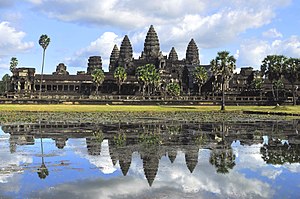Prang (architecture)
This article needs additional citations for verification. (December 2007) |

A prang (
Etymology
The term prang is a compound of the Sanskrit terms pra- ('forward, in front') and aṅga (limb of the body), with the contacting vowels united by sandhi.[1]
Structure
A Prang tower takes the form of a multi-tiered structure with receding size as it ascends. The receding size of almost identical roof structures of the stepped pyramidal tower, creates a
History
Khmer temples
Originally the Khmer prang temples were for the worship of the
, was relatively small for two reasons:- The rituals which were held in them were reserved for a small elite (in the capital of the Khmer only the god king could enter the shrine).
- The technology of the Khmer could not yet make large airy halls. (Ringis, 1990)
The cella was entered via a small porch, usually aligned to the east, which was called the
The Khmer prangs resembled north Indian temples' shikhara and rekha (temple towers) elements. The early 10th century and the late 12th century prangs in Thailand were influenced by the Khmer architects of the great temple complexes of Angkor Wat and Angkor Thom.
Thai temples

The first prangs in Thailand were built in
After the
A "more modern" Prang is a slim construction, like an ear of corn, which lets its Khmer origin be only suspected. The best example is
See also
References
- ^ Headley, Robert K.; Kylin Chhor; Lam Kheng Lim; Lim Hak Kheang; Chen Chun (1977). Cambodian-English Dictionary. Catholic University Press.
Literature
- Rita Ringis: Thai Temples And Temple Murals. Oxford University Press 1990, ISBN 0-19-588933-9
- K.I. Matics: Introduction To The Thai Temple. White Lotus Bangkok 1992, ISBN 974-8495-42-6
